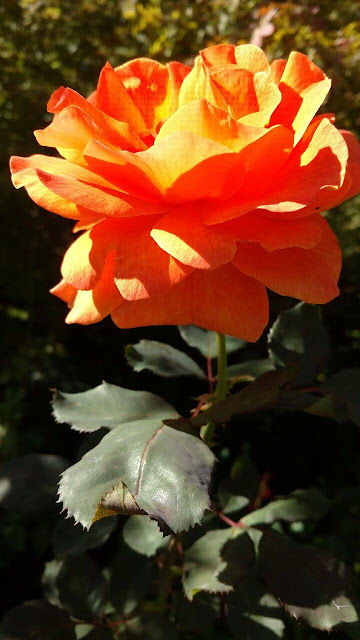October rose care: How to make the season last
 |
October brings out the orange (plus bronze foliage) of this
Vavoom floribunda rose. (Photos: Debbie Arrington) |
Tips to keep your bushes thriving and blooming
By Debbie Arrington
It's not only foliage that turns color in fall.
October roses look different. Reds seem darker, orange and yellow hues more intense. Light-colored or white petals tend to brown prematurely or bear the tiny tracks of hungry thrips. Leaves may turn burnished bronze, show signs of fungal damage or look ready to fall off. Bright red or orange hips -- rose fruit -- start to form.
These differences make fall rose care different, too. With Sacramento's mild autumn weather, there's still time to enjoy more flowers. But the bushes need a little extra TLC and observation to make the most of the final weeks of this growing season.
* October is when fungal diseases and certain pests tend to show up (again). It's the weather; those afternoons in the 70s and morning dew combine for optimal conditions. Blackspot and rust are the most common fungal problems and will basically defoliate the bush. (You want the plant to lose its leaves, but not until late December and pruning time.) Blackspot starts as yellow blotches, then lives up to its name; also aptly named, rust is the orange spores found on the underside of leaves.
Don't spray fungicide after seeing an outbreak; it's pretty much useless at this stage.
The best strategy is to contain these outbreaks before they spread. This also cuts down on outbreaks next spring. If you see an infected leaf, snip off the whole leaflet and dispose of it in the garbage (not in green waste or compost; that just spreads the fungus). If you see fallen leaves under your rose bushes, pick them up and dispose of them, too. These fungi lurk in fallen foliage and old mulch, awaiting new leaves and spring.
The best strategy is to contain these outbreaks before they spread. This also cuts down on outbreaks next spring. If you see an infected leaf, snip off the whole leaflet and dispose of it in the garbage (not in green waste or compost; that just spreads the fungus). If you see fallen leaves under your rose bushes, pick them up and dispose of them, too. These fungi lurk in fallen foliage and old mulch, awaiting new leaves and spring.
 |
| Gemini hybrid rose looks redder in fall weather. |
* Also be on the look out for spider mites; they love dry and dusty conditions. Strong blasts of water will clean the foliage and drown many mites.
* Aphids will attack new foliage and buds as bushes push out one last round of flowers. (They've been especially bad in my garden this month.) Blast them off with water, too, or squirt with insecticidal soap.
* Western flower thrips, which feed on petals before the buds open, cause scarring that's most notable on light-colored roses, especially white or cream blooms. Infected buds may look deformed; trim them off and dispose of them. (Winter weather will eventually take care of the other thrips.)
* Dead-head spent blooms, but avoid any hard pruning just yet. (Save that for winter dormancy.) Hybrid tea roses pruned now should rebloom in six to eight weeks, in time for Thanksgiving and December bouquets.
* Rose hips add color and interest to the fall garden, but delay them on most varieties until November. When rose hips form at the base of old blooms, that cues the bush that its work is over and it can go to sleep for the winter. When you delay hip formation, the bush continues to produce flowers.
 |
| The Mardi Gras floribunda rose shows all its colors in fall. |
* Remove browned roses or buds that refuse to open. Pick up browned blooms, too. Those discolored flowers often are infected with botrytis (good for wine grapes, bad for roses).
* Although you want more flowers, cut back on any fertilizer, especially nitrogen. (That prompts too much new growth.) Sprinkle a little bone meal instead.
* What the roses do need is water. October precipitation usually is not enough. Check that the bushes are getting the irrigation they need (about an inch a week).
* Windy weather can be a problem for climbing and tall roses, which can get whipped around by strong gusts. Tie down new canes to avoid wind damage.
* While outdoors checking your roses, remember to bring some blooms inside. With their rich colors, fall roses are among the prettiest of the year.
* To enjoy autumn roses at their best, check out the Sierra Foothills Rose Society annual show, noon to 5 p.m. Saturday, Oct. 20, at Green Acres Nursery & Supply, 205 Serpa Way, Folsom. Besides a great rose display, see arrangements and spectacular rose photography at this free special event. Get advice on specific rose issues as well as possible identification of mystery flowers. Learn more at www.sierrafoothillsrosesociety.org.
Debbie Arrington, a longtime rose grower and member of the Sacramento Rose Society, is a consulting rosarian.


Comments
Post a Comment